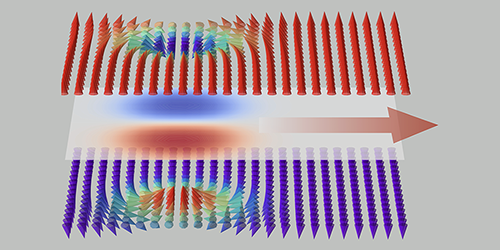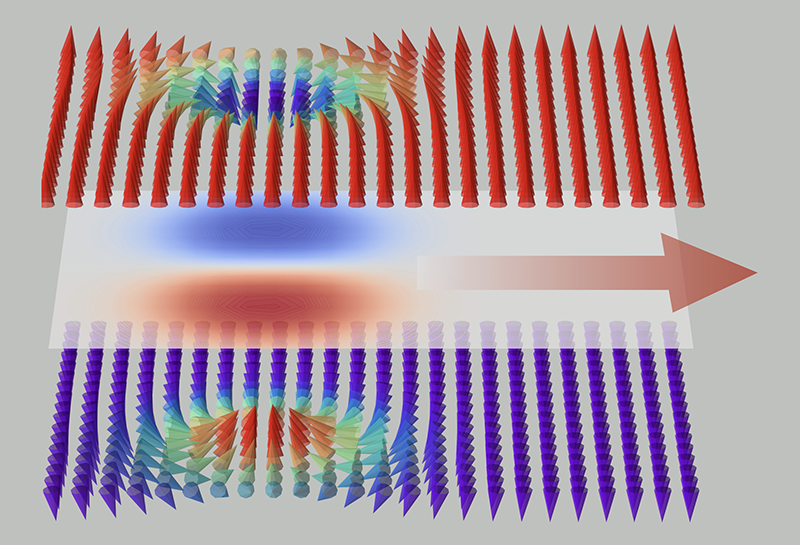August 18, 2025• Physics 18, 146
Pairs of skyrmions—tiny whirlpools that emerge in some magnetic materials—might be able to self-propel, a behavior reminiscent of that of active-matter systems such as motile bacteria.
C. C. de Souza Silva et al. [4]
Figure 1: Researchers have predicted that a bound skyrmion–skyrmion pair, formed by skyrmions with opposite chirality in coupled ferromagnetic layers, can display behavior mimicking that of active-matter systems [4]. In an alternating electromagnetic field that supplies internal energy to the pair, the object can display self-propulsion and self-reorientation.
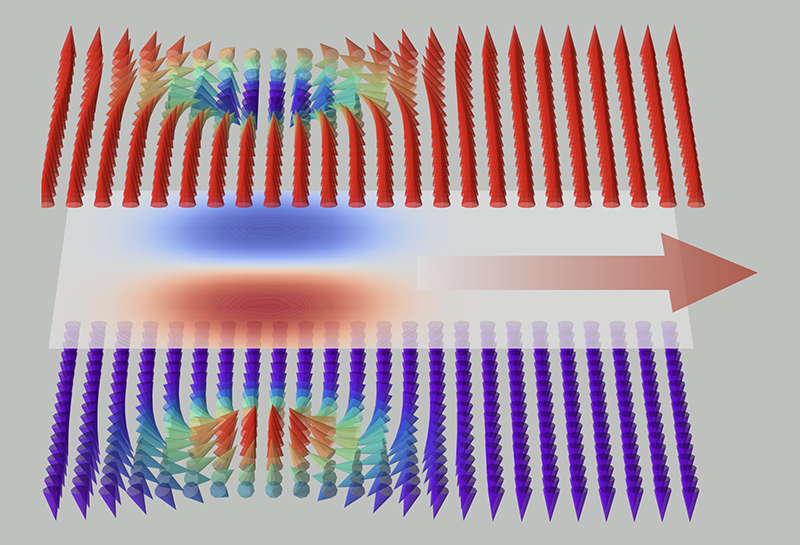
C. C. de Souza Silva et al. [4]
Figure 1: Researchers have predicted that a bound skyrmion–skyrmion pair, formed by skyrmions with opposite chirality in coupled ferromagnetic layers, can display behavior mimicking that of active-matter systems [4]. In an alternating electromagnetic field that supplies internal energy to the pair, the object can display self-propulsion and self-reorientation.×
In nature, the collective motion of birds and fish can generate impressive dynamics and unique structures, as seen in flocks of starlings and shoals of sardines. The science of active matter studies such complex behaviors across a wide range of scales and origins [1], and it has attracted growing interest over the past three decades. Active matter encompasses not only living things but also inanimate objects. Examples include active colloids [2] and active liquid crystals [3] that are able to self-propel—that is, move by themselves powered by internal energy sources. Now Clécio de Souza Silva and colleagues at the Federal University of Pernambuco in Brazil have suggested an intriguing addition to the active-matter catalog: coupled pairs of skyrmions, whirlpool-like spin arrangements that emerge in certain magnetic materials. Their theoretical work shows that such skyrmion pairs might be able to move at speeds exceeding those observed in any active-matter system [4]. The behavior might encourage nonconventional and bioinspired computing devices based on skyrmion manipulation. For example, a magnetic film with many self-propelled skyrmions may serve as a dynamic reservoir for reservoir computing.
The collective dynamics of active matter are governed by the motion of each individual entity, by the interactions among all entities, and by their interactions with the environment. An important class of active matter involves chiral systems—those with left- or right-handedness—which can display both translational and rotational dynamics [5]. This behavior may lead to nontrivial phenomena that could be useful for practical applications. For example, some self-propelled particles could display circular, chiral motion, a behavior that may enable the selection of particles with specific chirality based on their dynamics [6]. Examples of chiral active matter include sperm cells, bacteria, and liquid crystals. One may expect that similar behavior might be uncovered in chiral quasiparticles moving in magnetic materials, but research on the topic is lacking.
In magnetic films and multilayers, a delicate competition between different types of electromagnetic and quantum interactions can give rise to localized chiral spin textures that carry integer topological charges [7]. The chiral skyrmion is a paradigmatic example of these textures [8]. A nanoscale chiral skyrmion is made of a small number of spins that form a circular, chiral domain wall. Such an object can be regarded as a rigid particle that can be driven into translational motion by an external driving force [9]. A distinctive dynamic feature of chiral skyrmions is the so-called Hall motion, which is induced by electric currents and can lead to the accumulation of skyrmions at the edges of a device. Other characteristic behaviors of chiral skyrmions include ballistic motion, breathing-mode oscillations, and the ability to diffuse thermally. In all these cases, chiral skyrmions are considered as passive quasiparticles, whose dynamics is driven by external forces or gradients. But can they move by themselves?
Through computational simulations, de Souza Silva and colleagues indicate that this is indeed a possibility: A bound pair of chiral skyrmions in a synthetic antiferromagnetic bilayer can function as self-propelled chiral active matter (Fig. 1). The researchers consider a bilayer structure comprising two exchange-coupled chiral ferromagnetic layers with opposite chirality and magnetization (together, they thus behave as an antiferromagnet). In such a structure, skyrmions in one ferromagnetic layer are mirror images of those in the other layer, and two skyrmions can form a bound pair held together by a bond.
The researchers find that the autonomous motion of skyrmion pairs can be driven by the internal energy the skyrmions possess when immersed in an alternating electric or magnetic field. They show that an alternating electric or magnetic field can excite symmetric and antisymmetric breathing modes of the skyrmion pair. Both breathing modes modulate the skyrmion–skyrmion bond, meaning that the bond length can dynamically vary. This modulation creates a “stroke” that allows the skyrmions to “swim.” This motion results in the self-propulsion of the bound skyrmion pair, which can reach speeds of up to a hundred million body lengths per second. Since the net drift is governed by nonreciprocal variations in the skyrmion pair’s internal configuration, and the external drive merely fuels these internal dynamics, the motion can be considered self-propulsion.
APS/Carin Cain
Figure 2: Sketch of the run-and-tumble (top) and run-and-reverse (bottom) motion of bacteria. The chiral skyrmions investigated by de Souza Silva and collaborators hold promise for engineering self-propelled magnetic structures with similar navigation abilities.
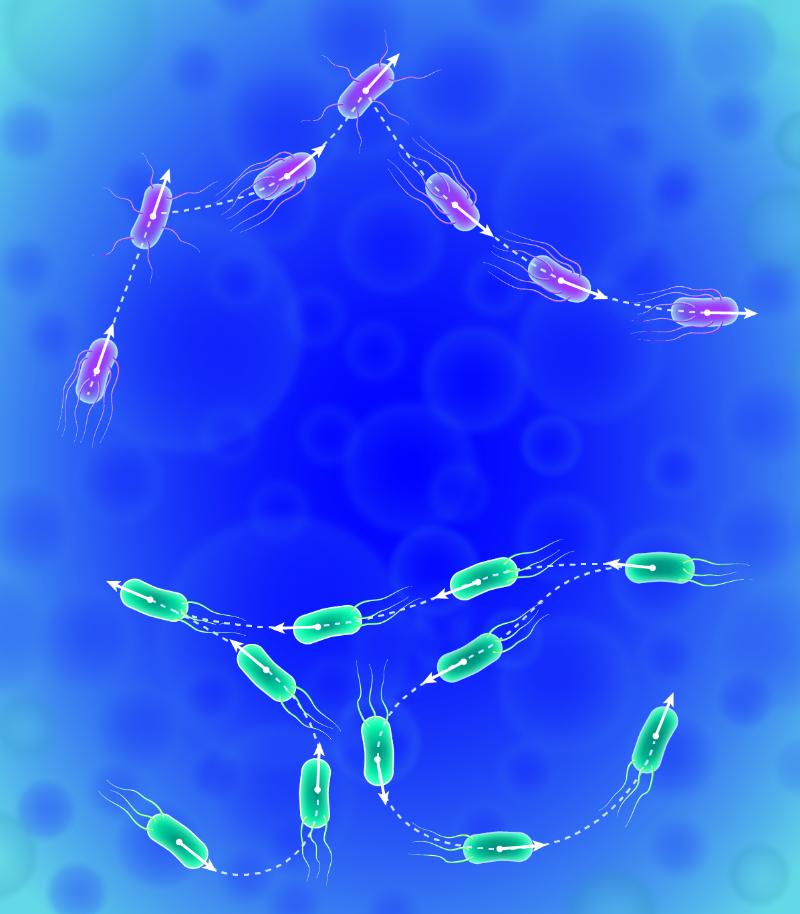
APS/Carin Cain
Figure 2: Sketch of the run-and-tumble (top) and run-and-reverse (bottom) motion of bacteria. The chiral skyrmions investigated by de Souza Silva and collaborators hold promise for engineering self-propelled magnetic structures with similar navigation abilities.×
The researchers also study the effect of weak thermal noise on the skyrmion motion. They find that noisy fluctuations can trigger a “run-and-reverse” pattern, in which a moving skyrmion pair halts and temporarily reverses direction. While self-propulsion emerges because of the oscillatory bond dynamics, the random spontaneous reorientations of the bond that cause an inversion of direction are induced by thermal noise. Run-and-reverse motion is a characteristic behavior of motile bacteria exploring complex environments. This resemblance establishes an intriguing connection between motile bacteria and other Brownian active particles on the one hand and chiral skyrmions and chiral active particles on the other. Bridging concepts from active matter and spintronics, the results will likely motivate new studies of self-propelling quasiparticles or magnetic defects. These studies could address the possibility of various navigation strategies—from run and reverse to run and tumble (Fig. 2)—that allow particle-like objects to harness noise to explore their surroundings.
Researchers may also be inspired to investigate other complex and fascinating behaviors that appear in the presence of more complex interactions, such as self-assembly and pattern formation. A key to these studies will be considering the interactions among a large number of self-propelled skyrmions as well as the interactions between the skyrmions and structured surfaces or interfaces. Effects of an artificially modified substrate could turn out to be particularly rich. A recent study, for example, indicated that the interaction of chiral skyrmions undergoing Brownian motion with chiral flower-like obstacles can lead to the possibility of sorting the skyrmions by topology [10]. Another interesting feature of the skyrmions is the lifetime of their motility, which, depending on temperature and on the used magnetic material, could range from a few days to years. In chemically powered active particles and biological systems, in contrast, particle activity typically has a shorter temporal decay, limited by the depletion of chemicals or nutrients. The tunable, long-lived active skyrmion systems could thus offer ideal systems for producing long-term emergent collective behaviors in active-matter experiments.
The recent attention on chiral skyrmions has largely been driven by their great potential to be used as nonvolatile information carriers and quantum bits in spintronic devices. We believe, however, that other mysterious facets of chiral skyrmions and other quasiparticles in different systems remain to be discovered, as the work by de Sousa Silva and colleagues suggests.
References
- C. Bechinger et al., “Active particles in complex and crowded environments,” Rev. Mod. Phys. 88, 045006 (2016).
- A. Zöttl and H. Stark, “Emergent behavior in active colloids,” J. Phys.: Condens. Matter 28, 253001 (2016).
- R. Zhang et al., “Autonomous materials systems from active liquid crystals,” Nat. Rev. Mater. 6, 437 (2021).
- C. C. de Souza Silva et al., “Emergent self-propulsion of skyrmionic matter in synthetic antiferromagnets,” Phys. Rev. Lett. 135, 086701 (2025).
- B. Liebchen and D. Levis, “Chiral active matter,” Europhys. Lett. 139, 67001 (2022).
- M. Mijalkov and G. Volpe, “Sorting of chiral microswimmers,” Soft Matter 9, 6376 (2013).
- W. Jiang et al., “Skyrmions in magnetic multilayers,” Phys. Rep. 704, 1 (2017).
- A. N. Bogdanov and C. Panagopoulos, “Physical foundations and basic properties of magnetic skyrmions,” Nat. Rev. Phys. 2, 492 (2020).
- C. Reichhardt et al., “Statics and dynamics of skyrmions interacting with disorder and nanostructures,” Rev. Mod. Phys. 94, 035005 (2022).
- X. Zhang et al., “Chiral skyrmions interacting with chiral flowers,” Nano Lett. 23, 11793 (2023).
About the Authors
Xichao Zhang is an assistant professor at Waseda University in Japan. He received his PhD from Shinshu University in 2018. He is interested in dynamic phenomena that occur in spintronics, magnetism, and soft-matter systems. His recent research focuses on the dynamics and functionalization of interacting quasiparticles on artificially nanostructured surfaces and interfaces. He also works on interdisciplinary problems that bridge skyrmionics with active-matter and fluid science. He is a recipient of the Waseda Research Award, the JSPS postdoctoral fellowship, and the CUHKSZ presidential postdoctoral fellowship. He is a senior member of the IEEE and a member of the American Physical Society.

Masahito Mochizuki is a professor at Waseda University in Japan. He received his PhD from the University of Tokyo in 2003. His area of expertise is theoretical condensed-matter physics, and his research interests include strongly correlated electron systems, multiferroics, spintronics, topological magnetism, and photoinduced nonequilibrium phenomena. He is a member of the Physical Society of Japan, the Japan Society of Applied Physics, and the Magnetics Society of Japan.
Subject AreasMagnetismCondensed Matter PhysicsRelated Articles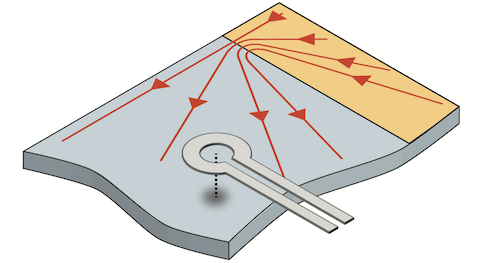
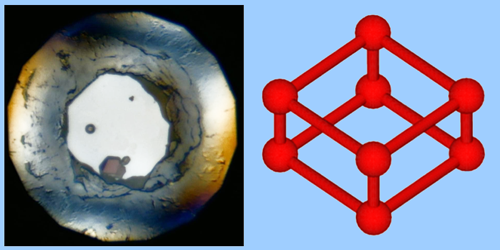
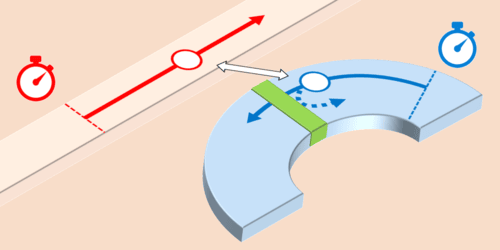 More Articles
More Articles
